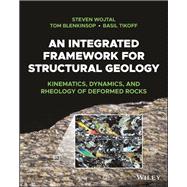A modern and practice-oriented approach to structural geology
An Integrated Framework for Structural Geology: Kinematics, Dynamics, and Rheology of Deformed Rocks builds a framework for structural geology from geometrical description, kinematic analysis, dynamic evolution, and rheological investigation of deformed rocks. The unique approach taken by the book is to integrate these principles of continuum mechanics with the description of rock microstructures and inferences about deformation mechanisms. Field, theoretical and laboratory approaches to structural geology are all considered, including the application of rock mechanics experiments to nature.
Readers will also find:
- Three case studies that illustrate how the framework can be applied to deformation at different levels in the crust and in an applied structural geology context
- Hundreds of detailed, two-color illustrations of exceptional clarity, as well as many microstructural and field photographs
- The quantitative basis of structural geology delivered through clear mathematics
Written for advanced undergraduate and graduate students in geology, An Integrated Framework for Structural Geology will also earn a place in the libraries of practicing geologists with an interest in a one-stop resource on structural geology.








